The Esoteric Nature of Death Preparations in Taoism and Their Possible Sources
Abstract
Stephen Eskildsen has analysed a corpus of texts belonging to the Taoist tradition of internal alchemy, paying special attention to near-death meditations. Taking Eskildsen’s conclusions as the starting point, the main purpose of this paper is to show the similarities between death preparation techniques in Taoism (“entering the womb”, “changing the dwelling place” and “repelling killer demons”) and the esoteric practices of Tibetan Buddhism (The Six Yogas of Nāropa). The subject was chosen, firstly, because some of them were omitted by Eskildsen, and secondly because those similarities seem to be interesting in the context of establishing the possible sources of Taoist meditations. An attempt at analysing the origins of both sets of practices, and the relationships between them, led to the conclusion that the influence of Indian esoteric ideas on Chinese Taoism is highly probable. The author also noted that the breathing exercises that constitute the basis of all of the techniques in question are prior Buddhist influences, and thus the independent development of these practices is also possible. Such independent development may be considered interesting, as both Chinese and Tibetan techniques are based on a similar notion of mystical physiology, which subsequently could suggest some kind of universality.
References
A Dictionary of Buddhism, edited by Damien Keown, Oxford University Press, 2003.
Berounský, Daniel. “Entering dead bodies and the miraculous power of the kings:The Landmark of Karma Pakshi’s reincarnation in Tibet. Part I.” Akademia, www.academia.edu/3453461/Entering_dead_bodies_and_the_miraculous_power_of_the_Kings_The_landmark_of_Karma_Pakshis_reincarnation_in_Tibet_Part_I_. Accessed 6.03. 2020.
Berounský, Daniel. “Entering dead bodies and the miraculous power of the kings:The Landmark of Karma Pakshi’s reincarnation in Tibet. Part II.” Mongolo-Tibetica Pragensia ‘11, Linguistics, Ethnolinguistics, Religion and Culture, vol. 4, no.2, 2011, pp. 7-29. Academia, www.academia.edu/3453475/Entering_dead_bodies_and_the_miraculous_power_of_the_ Kings_ The_landmark_of_Karma_Pakshis_reincarnation_in_Tibet_Part_II_. Accessed 6.03. 2020.
Blezer, Hank, Kalzang Norbu Gurung, and Saraju Rath. “Where to Look For the Origins Zhang zhung-related Scripts?” Journal of the International Association for Bon Research, vol. 1, inaugural issue, 2013, pp. 99-127, himalaya.socanth.cam.ac.uk/collections/ journals/ jiabr/ pdf/JIABR_01_09.pdf. Accessed 3.05.2017.
Campany, Robert Ford. Making Transcendents. Ascetics and Social Memory in Early Medieval China. University of Hawaii Press, 2009.
Chou Yi-liang, “Tantrism in China.” Harvard Journal of Asiatic Studies, vol. 8, no. 3/4, 1945, pp. 241–332, www.jstor.org/stable/i327661. Accessed 6.03. 2020.
Cromie, William J. “Meditation Changes Temperatures.” Harvard Gazette, April 18 2002, news.harvard.edu/gazette/story/2002/04/meditation-changes-temperatures/. Accessed 3.05.2017.
Cuevas, Bryan J. The Hidden History of the Tibetan Book of the Dead. Oxford University Press, 2003.
Eliade, Mircea. Yoga, Immortality and Freedom. Translated from French by Willard R. Trusk, Routledge, New 1958.
Eskildsen, Stephen. “Emergency Death Meditations for Internal Alchemists.” T’oung Pao. Second Series, vol. 92, fasc. 4/5, 2006, pp. 373-409, www.jstor.org/stable/4529048. Accessed 6.03.2020.
Karmay, Samten G. “A Historical Overview of the Bon Religion.” Bon. The Magic Word. The Indigenous Religion of Tibet, edited Samten G. Karmay and Jeff Watt, Rubin Museum of Art & Philip Wilson Publishers, 2007.
Kohn, Livia. Introducing Daoism. Journal of Buddhist Ethics Online Books, 2008.
Kragh, Ulrich Timme. Tibetan Yoga and Mysticism. A Textual Study of the Yogas of Nāropa and Mahāmudrā Meditation In the Medieval Tradition of Dags po. Studia Philologica Buddhica Monograph Series XXXII. The International Institute for Buddhist Studies, 2015.
Kvaerne, Per. Tibet Bon Religion: A Death Ritual of the Tibetan Bonpos. Brill, 1985.
Martin, Dan. “Olmo Lungring: A Holly Place Here and Beyond.” Bon. The Magic Word. The Indigenous Religion of Tibet, edited Samten G. Karmay and Jeff Watt, Rubin Museum of Art & Philip Wilson Publishers, 2007, pp. 99-123.
Lao Tzu. Tao Te Ching: The Classic Book of Integrity and the Way. Translation and afterword by Victor H. Mair, Bantam Books, 1990.
Po-Chi Huang. “The cult of Vetāla and Tantric Fantasy.” Rethinking Ghosts in World Religions, edited by Mu-Chou Poo. Numen Book Series, Studies in the History of Religions, Vol. 123, Brill, 2009, pp. 211-235.
Roth, Harold David. Original Dao. Inward Training (Nei-yeh) and the Foundations of Taoist Mysticism. Columbia University Press, 1999.
Snellgrove, David L. The Nine Ways of Bon: Excerpts from Gzi-brjid. Oxford University Press, 1967.
Sørensen, Henrik. “On Esoteric Buddhism in China: A Working Definition.” Esoteric Buddhism and the Tantras in East Asia, edited by Charles D. Orzech, Henrik S. Sørensen, and Richard K. Payne, Brill, 2011.
Teiser, Stephen. The Scripture of Ten Kings and the Making Purgatory in Medieval Chinese Buddhism. University of Hawaii Press, 1994.
The Encyclopedia of Taoism, edited by Fabrizio Pregadio, Routledge, 2008, p. 553, entry: jindan by Fabrizio Pregadio; p. 282, entry: chushen by Maruyama Huroshi; p. 1081, entry: wuzhen pian, 3. neidan by Martina Darga; p. 777, entry: niwan by Monica Esposito.
The Practice of The Six Yogas of Nāropa. Translated and edited by Glenn H. Mullin, Snow Lion Publications, 2006, e-pub edition.
Trzy traktaty o sztuce umierania. Translated by Maciej Włodarski, Wydawnictwo Uniwersyetu Jagiellońskiego, 2015.
White, David Gordon. Sinister Yogis. University of Chicago Press, 2009.
Copyright (c) 2020 Roczniki Humanistyczne

This work is licensed under a Creative Commons Attribution-NonCommercial-NoDerivatives 4.0 International License.





